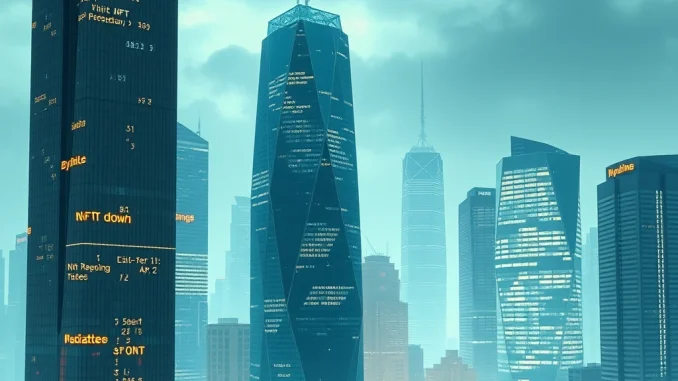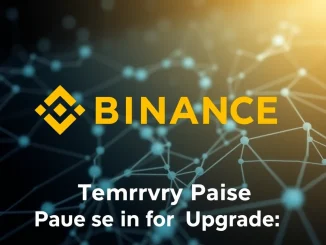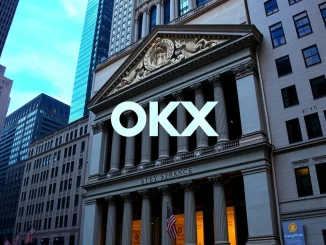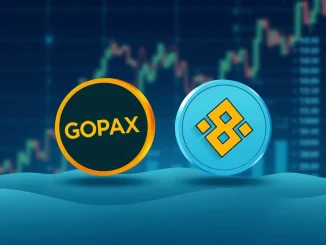
In a sudden turn of events that has sent ripples through the crypto community, Bybit, a prominent crypto exchange, has announced the closure of its NFT marketplace. Effective April 8th, Bybit will discontinue its NFT Marketplace, Inscription Marketplace, and decentralized exchange (DEX) offering. This move, initially reported by Cointelegraph, underscores the harsh realities of the current digital asset landscape, particularly the significant downturn in the NFT market. Is this the end of the NFT hype, or just a strategic retreat?
Why is Bybit Shutting Down its NFT Marketplace?
The primary driver behind Bybit’s decision is the pronounced market slump affecting the NFT sector. Let’s break down the numbers to understand the severity:
- Dramatic Volume Decline: Daily trading volume for NFTs has plummeted by a staggering 70% compared to last year.
- Peak to Trough: When measured against the euphoric highs of December 2024, the drop is even more precipitous – over 95%.
- Fading Speculative Interest: The initial frenzy surrounding speculative NFTs has largely dissipated as investor appetite wanes.
These figures paint a clear picture: the once-booming NFT market is facing a significant correction, and Bybit’s exit from the space reflects a pragmatic response to these challenging conditions.
Bybit’s NFT Marketplace Closure: A Sign of the Times?
Bybit isn’t alone in navigating the complexities of the fluctuating crypto world. Their decision to streamline services and shut down the NFT marketplace, Inscription Marketplace, and DEX offering is indicative of a broader trend within the industry. Exchanges are constantly evaluating market conditions and adjusting their strategies to remain competitive and sustainable. This often involves focusing on core strengths and exiting less profitable or strategically aligned ventures.
Here’s what Bybit’s move signals about the current crypto climate:
- Increased Prudence: Crypto exchanges are becoming more cautious in their expansion and service offerings.
- Focus on Core Services: There’s a renewed emphasis on core exchange functionalities like spot and derivatives trading.
- Market Realignment: The industry is undergoing a period of realignment, with companies adapting to shifting investor preferences and market dynamics.
The Resilient Few: Not All NFTs Are Created Equal
While the overall NFT market is experiencing a downturn, it’s crucial to acknowledge that pockets of resilience remain. The report specifically mentions projects like Doodles and Pudgy Penguins. These collections have managed to maintain a degree of stability and community engagement despite the broader market trends. What sets them apart?
Several factors contribute to the enduring appeal of certain NFT projects:
- Strong Community: Projects with active and loyal communities tend to weather market storms better.
- Utility and Value Beyond Speculation: NFTs that offer real-world utility, exclusive access, or strong brand value are more likely to retain value.
- Established Brands: Collections from well-known artists or brands often have a built-in audience and credibility.
However, even these resilient projects are likely feeling the pressure of the general market sentiment. The era of indiscriminate NFT buying and selling seems to be over, replaced by a more discerning and selective approach from investors.
What Does This Mean for the Future of NFTs?
Bybit’s exit from the NFT marketplace space is undoubtedly a significant event, but it doesn’t necessarily spell the end for NFTs as a whole. Instead, it might represent a necessary correction and maturation of the market. Here’s a look at potential future trajectories:
Potential Future Trends for NFTs:
| Trend | Description |
|---|---|
| Focus on Utility: | NFTs will increasingly be valued for their practical applications beyond digital collectibles, such as ticketing, memberships, and in-game assets. |
| Increased Regulation: | As the NFT market matures, we can expect greater regulatory scrutiny and potentially clearer legal frameworks. |
| Integration with Metaverse and Gaming: | NFTs are poised to play a crucial role in the development of metaverses and blockchain gaming, providing ownership and interoperability for digital assets. |
| Fractionalization and Accessibility: | Fractional NFTs could make high-value NFTs more accessible to a wider range of investors. |
The crypto exchange landscape is dynamic, and the NFT sector is still evolving. Bybit’s strategic shift reflects the need for adaptability in this ever-changing environment. While the speculative frenzy around NFTs may have cooled, the underlying technology and its potential applications remain compelling. The future of NFTs likely lies in projects that offer tangible value, build strong communities, and adapt to the evolving demands of the digital asset space.
Actionable Insights for NFT Enthusiasts and Investors
Navigating the current NFT market requires a more nuanced approach. Here are some actionable insights for those interested in NFTs:
- Due Diligence is Key: Thoroughly research any NFT project before investing. Understand its utility, community, and team.
- Focus on Long-Term Value: Shift away from short-term speculation and look for projects with long-term potential.
- Diversify Your Portfolio: Don’t put all your eggs in one basket. Diversify your crypto portfolio and NFT holdings.
- Stay Informed: Keep abreast of market trends, regulatory developments, and project updates within the NFT space.
Conclusion: Navigating the NFT Winter
Bybit’s decision to shutter its NFT marketplace serves as a stark reminder of the volatile nature of the crypto market and the cyclicality of trends. The current market slump in NFTs is undeniable, but it also presents an opportunity for the sector to mature and for valuable projects to emerge. While the days of explosive growth may be temporarily on hold, the underlying innovation and potential of NFTs remain. For investors and enthusiasts, the key is to approach the NFT market with caution, conduct thorough research, and focus on projects with genuine utility and lasting value. The NFT winter may be here, but spring will eventually follow, and those who navigate this period wisely will be best positioned to benefit from the next wave of innovation.



